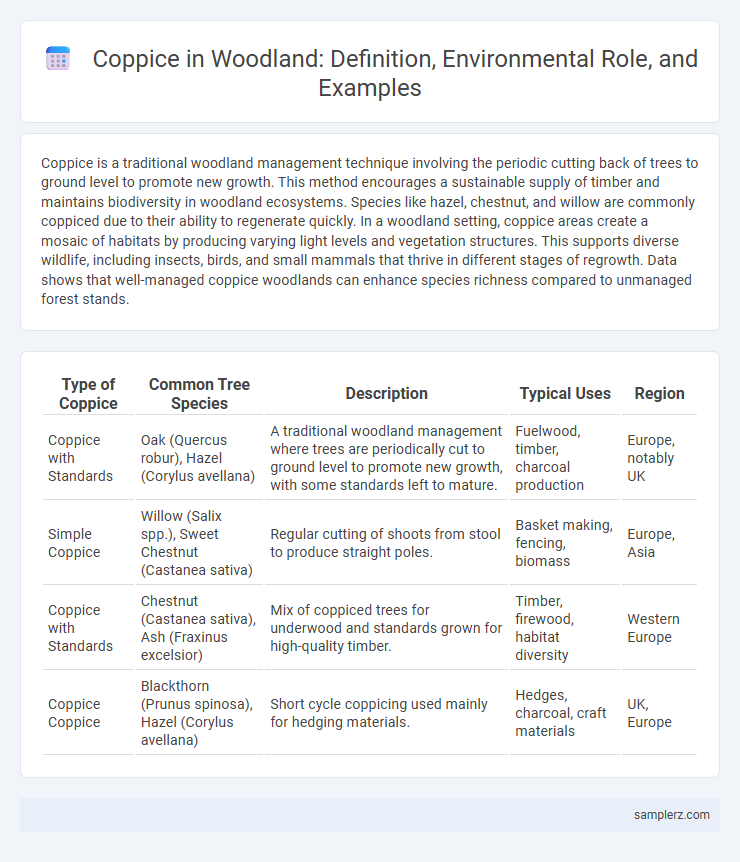Coppice is a traditional woodland management technique involving the periodic cutting back of trees to ground level to promote new growth. This method encourages a sustainable supply of timber and maintains biodiversity in woodland ecosystems. Species like hazel, chestnut, and willow are commonly coppiced due to their ability to regenerate quickly. In a woodland setting, coppice areas create a mosaic of habitats by producing varying light levels and vegetation structures. This supports diverse wildlife, including insects, birds, and small mammals that thrive in different stages of regrowth. Data shows that well-managed coppice woodlands can enhance species richness compared to unmanaged forest stands.
Table of Comparison
| Type of Coppice | Common Tree Species | Description | Typical Uses | Region |
|---|---|---|---|---|
| Coppice with Standards | Oak (Quercus robur), Hazel (Corylus avellana) | A traditional woodland management where trees are periodically cut to ground level to promote new growth, with some standards left to mature. | Fuelwood, timber, charcoal production | Europe, notably UK |
| Simple Coppice | Willow (Salix spp.), Sweet Chestnut (Castanea sativa) | Regular cutting of shoots from stool to produce straight poles. | Basket making, fencing, biomass | Europe, Asia |
| Coppice with Standards | Chestnut (Castanea sativa), Ash (Fraxinus excelsior) | Mix of coppiced trees for underwood and standards grown for high-quality timber. | Timber, firewood, habitat diversity | Western Europe |
| Coppice Coppice | Blackthorn (Prunus spinosa), Hazel (Corylus avellana) | Short cycle coppicing used mainly for hedging materials. | Hedges, charcoal, craft materials | UK, Europe |
Introduction to Coppicing in Woodlands
Coppicing is a traditional woodland management technique involving the periodic cutting of trees, such as hazel or chestnut, near ground level to promote new growth. This method encourages biodiversity by creating diverse habitats that support various wildlife species, including birds and insects. Regular coppicing cycles, typically every 7 to 20 years, maintain a sustainable supply of timber and enhance woodland health.
Historical Significance of Coppice Management
Coppice management, practiced since ancient times, played a crucial role in sustainable woodland resource use by promoting rapid regrowth of trees like hazel, oak, and chestnut. This method supported medieval economies by providing consistent supplies of timber for fuel, fencing, and construction without deforesting large areas. Archaeological evidence from Europe showcases how coppicing shaped historic landscapes and influenced biodiversity through cyclical woodland harvesting.
Typical Tree Species Used for Coppice
Typical tree species used for coppice in woodland include hazel (Corylus avellana), hornbeam (Carpinus betulus), and sweet chestnut (Castanea sativa), which regenerate quickly after cutting. Oak (Quercus robur) also serves as a coppice species, providing durable timber and promoting biodiversity. These species are selected for their vigorous coppicing response, sustainable wood production, and ability to support diverse woodland ecosystems.
Ecological Benefits of Coppicing
Coppicing in woodland ecosystems promotes biodiversity by creating a mosaic of light conditions that support diverse plant and animal species. This traditional management technique enhances soil fertility through increased leaf litter and root turnover, fostering nutrient cycling and habitat complexity. Frequent cutting cycles also maintain open habitats essential for pollinators and ground-nesting birds, contributing to overall ecosystem resilience.
Traditional Coppice Woodland Examples
Traditional coppice woodland examples include the ancient hazel coppices of the Weald in Southeast England, where periodic cutting promotes biodiversity and sustainable timber production. Another notable example is the ancient coppice woods of the New Forest, renowned for supporting diverse flora and fauna through rotational cutting cycles. These managed woodlands demonstrate centuries-old practices that enhance habitat variety and preserve cultural heritage.
Modern Coppice Practices in Sustainable Forestry
Modern coppice practices in sustainable forestry emphasize selective cutting techniques that promote rapid regrowth and biodiversity within woodlands. Utilizing species such as hazel, chestnut, and willow, these methods maintain soil health while providing continuous habitat for wildlife. Integrating coppice cycles with forest management plans enhances carbon sequestration and supports ecosystem resilience.
Wildlife Supported by Coppice Woodlands
Coppice woodlands provide vital habitats for diverse wildlife species, including dormice, nightingales, and various butterflies dependent on young, dense growth for shelter and food. The cyclical cutting and regrowth in coppicing maintain a mosaic of light and shade, promoting rich understorey flora that supports insects and ground-nesting birds. Managed coppice areas enhance biodiversity by preserving structural diversity and resource availability in temperate woodland ecosystems.
Notable Coppiced Woodlands Around the World
Wistman's Wood in Dartmoor, England, showcases ancient oak coppice with centuries-old stool stools that support diverse understory flora. In Germany, the Black Forest features managed coppice systems promoting sustainable timber and rich biodiversity. France's Forest of Troncais is renowned for its oak coppice, which balances ecological health and traditional forestry practices.
Challenges Facing Coppice Management Today
Coppice management in woodlands faces challenges such as reduced biodiversity due to modern forestry practices favoring uniform tree stands and increased deer populations that hinder regrowth by browsing young shoots. Climate change exacerbates these issues by altering growth cycles and increasing susceptibility to pests and diseases, undermining traditional coppice cycles. Maintaining sustainable coppice rotations requires balancing ecological health with economic viability amidst changing environmental conditions.
Future Trends in Coppice Woodland Conservation
Future trends in coppice woodland conservation emphasize integrating traditional management with modern ecological practices to enhance biodiversity and carbon sequestration. Emerging techniques include adaptive coppicing cycles informed by remote sensing technology and habitat monitoring, ensuring sustainable growth and wildlife support. Increased community involvement and policy incentives aim to secure the long-term viability of coppiced woodlands within changing climate conditions.

example of coppice in woodland Infographic
 samplerz.com
samplerz.com